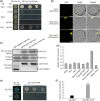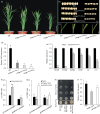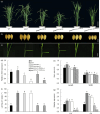Separable regulation of POW1 in grain size and leaf angle development in rice
- PMID: 34343399
- PMCID: PMC8633490
- DOI: 10.1111/pbi.13677
Separable regulation of POW1 in grain size and leaf angle development in rice
Abstract
Leaf angle is one of the key factors that determines rice plant architecture. However, the improvement of leaf angle erectness is often accompanied by unfavourable changes in other traits, especially grain size reduction. In this study, we identified the pow1 (put on weight 1) mutant that leads to increased grain size and leaf angle, typical brassinosteroid (BR)-related phenotypes caused by excessive cell proliferation and cell expansion. We show that modulation of the BR biosynthesis genes OsDWARF4 (D4) and D11 and the BR signalling gene D61 could rescue the phenotype of leaf angle but not grain size in the pow1 mutant. We further demonstrated that POW1 functions in grain size regulation by repressing the transactivation activity of the interacting protein TAF2, a highly conserved member of the TFIID transcription initiation complex. Down-regulation of TAF2 rescued the enlarged grain size of pow1 but had little effect on the increased leaf angle phenotype of the mutant. The separable functions of the POW1-TAF2 and POW1-BR modules in grain size and leaf angle control provide a promising strategy for designing varieties with compact plant architecture and increased grain size, thus promoting high-yield breeding in rice.
Keywords: POW1; TAF2; brassinosteroid.; grain size; leaf angle; rice.
© 2021 The Authors. Plant Biotechnology Journal published by Society for Experimental Biology and The Association of Applied Biologists and John Wiley & Sons Ltd.
Conflict of interest statement
The authors declare no conflict of interest.
Figures








Similar articles
-
SLG controls grain size and leaf angle by modulating brassinosteroid homeostasis in rice.J Exp Bot. 2016 Jul;67(14):4241-53. doi: 10.1093/jxb/erw204. Epub 2016 Jun 1. J Exp Bot. 2016. PMID: 27252468 Free PMC article.
-
The Rice Basic Helix-Loop-Helix 79 (OsbHLH079) Determines Leaf Angle and Grain Shape.Int J Mol Sci. 2020 Mar 18;21(6):2090. doi: 10.3390/ijms21062090. Int J Mol Sci. 2020. PMID: 32197452 Free PMC article.
-
The basic helix-loop-helix transcription factor OsBLR1 regulates leaf angle in rice via brassinosteroid signalling.Plant Mol Biol. 2020 Apr;102(6):589-602. doi: 10.1007/s11103-020-00965-5. Epub 2020 Feb 5. Plant Mol Biol. 2020. PMID: 32026326
-
Phytohormones signaling and crosstalk regulating leaf angle in rice.Plant Cell Rep. 2016 Dec;35(12):2423-2433. doi: 10.1007/s00299-016-2052-5. Epub 2016 Sep 13. Plant Cell Rep. 2016. PMID: 27623811 Review.
-
Brassinosteroid-mediated regulation of agronomic traits in rice.Plant Cell Rep. 2014 May;33(5):683-96. doi: 10.1007/s00299-014-1578-7. Epub 2014 Mar 26. Plant Cell Rep. 2014. PMID: 24667992 Free PMC article. Review.
Cited by
-
DGW1, encoding an hnRNP-like RNA binding protein, positively regulates grain size and weight by interacting with GW6 mRNA.Plant Biotechnol J. 2024 Feb;22(2):512-526. doi: 10.1111/pbi.14202. Epub 2023 Oct 20. Plant Biotechnol J. 2024. PMID: 37862261 Free PMC article.
-
SLG2 specifically regulates grain width through WOX11-mediated cell expansion control in rice.Plant Biotechnol J. 2023 Sep;21(9):1904-1918. doi: 10.1111/pbi.14102. Epub 2023 Jun 21. Plant Biotechnol J. 2023. PMID: 37340997 Free PMC article.
-
The Mediator subunit OsMED23 associates with the histone demethylase OsJMJ703 and the transcription factor OsWOX3A to control grain size and yield in rice.Proc Natl Acad Sci U S A. 2025 Mar 25;122(12):e2419464122. doi: 10.1073/pnas.2419464122. Epub 2025 Mar 21. Proc Natl Acad Sci U S A. 2025. PMID: 40117312
-
The Harbinger transposon-derived gene PANDA epigenetically coordinates panicle number and grain size in rice.Plant Biotechnol J. 2022 Jun;20(6):1154-1166. doi: 10.1111/pbi.13799. Epub 2022 Mar 16. Plant Biotechnol J. 2022. PMID: 35239255 Free PMC article.
-
The general transcription factors (GTFs) of RNA polymerase II and their roles in plant development and stress responses.Crit Rev Biochem Mol Biol. 2024 Oct;59(5):267-309. doi: 10.1080/10409238.2024.2408562. Epub 2024 Oct 3. Crit Rev Biochem Mol Biol. 2024. PMID: 39361782 Review.
References
-
- Ang, L.H. , Chattopadhyay, S. , Wei, N. , Oyama, T. , Okada, K. , Batschauer, A. and Deng, X.W. (1998) Molecular interaction between COP1 and HY5 defines a regulatory switch for light control of Arabidopsis development. Mol. Cell, 1, 213–222. - PubMed
-
- Asami, T. , Mizutani, M. , Fujioka, S. , Goda, H. , Min, Y.K. , Shimada, Y. , Nakano, T. et al. (2001) Selective interaction of triazole derivatives with DWF4, a cytochrome P450 monooxygenase of the brassinosteroid biosynthetic pathway, correlates with brassinosteroid deficiency in Planta. J. Biol. Chem. 276, 25687–25691. - PubMed
-
- Bahat, A. , Kedmi, R. , Gazit, K. , Richardo‐Lax, I. , Ainbinder, E. and Dikstein, R. (2013) TAF4b and TAF4 differentially regulate mouse embryonic stem cells maintenance and proliferation. Genes Cells, 18, 225–237. - PubMed
Publication types
MeSH terms
Substances
LinkOut - more resources
Full Text Sources
Other Literature Sources

